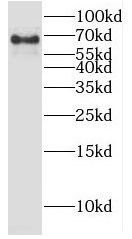Products
HIC1 antibody
Category:
Research Area:
- SPECIFICATIONS
- Product Name
- HIC1 antibody
- Catalogue No.
- FNab03857
- Size
- 100μg
- Form
- liquid
- Purification
- Immunogen affinity purified
- Purity
- ≥95% as determined by SDS-PAGE
- Clonality
- polyclonal
- Isotype
- IgG
- Storage
- PBS with 0.02% sodium azide and 50% glycerol pH 7.3, -20℃ for 12 months(Avoid repeated freeze / thaw cycles.)
Immunogen
- Immunogen
- hypermethylated in cancer 1
- Alternative Names
- ZBTB29 antibody
- UniProt ID
- Q14526
- Observed MW
- 65-70 kDa
Application
- Tested Applications
- ELISA, IHC, WB
- Recommended dilution
- WB: 1:500-1:2000; IHC: 1:20-1:200
Validated Images
 Jurkat cells were subjected to SDS PAGE followed by western blot with FNab03857(HIC1 Antibody) at dilution of 1:1000
Jurkat cells were subjected to SDS PAGE followed by western blot with FNab03857(HIC1 Antibody) at dilution of 1:1000
 Immunohistochemistry of paraffin-embedded human testis tissue slide using FNab03857(HIC1 Antibody) at dilution of 1:50
Immunohistochemistry of paraffin-embedded human testis tissue slide using FNab03857(HIC1 Antibody) at dilution of 1:50
- Background
- Transcriptional repressor. Recognizes and binds to the consensus sequence '5-[CG]NG[CG]GGGCA[CA]CC-3'. May act as a tumor suppressor. May be involved in development of head, face, limbs and ventral body wall. Involved in down-regulation of SIRT1 and thereby is involved in regulation of p53/TP53-dependent apoptotic DNA-damage responses. The specific target gene promoter association seems to be depend on corepressors, such as CTBP1 or CTBP2 and MTA1. The regulation of SIRT1 transcription in response to nutrient deprivation seems to involve CTBP1. In cooperation with MTA1(indicative for an association with the NuRD complex) represses transcription from CCND1/cyclin-D1 and CDKN1C/p57Kip2 specifically in quiescent cells. Involved in regulation of the Wnt signaling pathway probably by association with TCF7L2 and preventing TCF7L2 and CTNNB1 association with promoters of TCF-responsive genes. Seems to repress transcription from E2F1 and ATOH1 which involves ARID1A, indicative for the participation of a distinct SWI/SNF-type chromatin-remodeling complex. Probably represses transcription from ACKR3, FGFBP1 and EFNA1.



